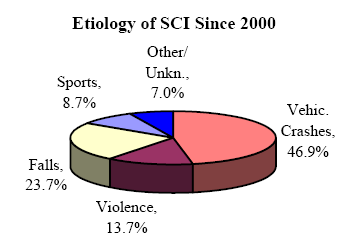Spinal Cord Injury (SCI)

Spinal Cord Injury (SCI) is damage to the spinal cord that results in a loss of function such as mobility or feeling. Frequent causes of damage are trauma (car accidents, gunshots, falls, etc.) or disease (polio, spina bifida, Friedreich's Ataxia, etc.). The spinal cord does not have to be severed in order for a loss of functioning to occur. In fact, in most cases of SCI, the spinal cord is intact, but the damage to it results in loss of functioning. Almost 11,000 people in the U.S. sustain a traumatic spinal cord injury each year, resulting in temporary or permanent sensory deficit, motor deficit, or bowel or bladder dysfunction. In this country, nearly 200,000 people live with paralysis caused by SCI. More than half the people who sustain an SCI are between 16 and 30 years old. More males than females sustain this type of injury -- the ratio is more than four to one. The most common cause of SCI is motor vehicle crashes, accounting for at least 36 percent of these injuries (broken down as follows: no restraints used, 20%; restraints used, 13.7%; motorcycle, 7.4%; accidents involving pedestrians, 5.2%; other, 2.1%). Violence-related SCIs have been steadily increasing over the past two decades, and today, violence is associated with 29 percent of SCIs. Falls and sports cause 21 percent and 7 percent of SCI cases, respectively.

 The Schupak Law Firm Home
The Schupak Law Firm Home


